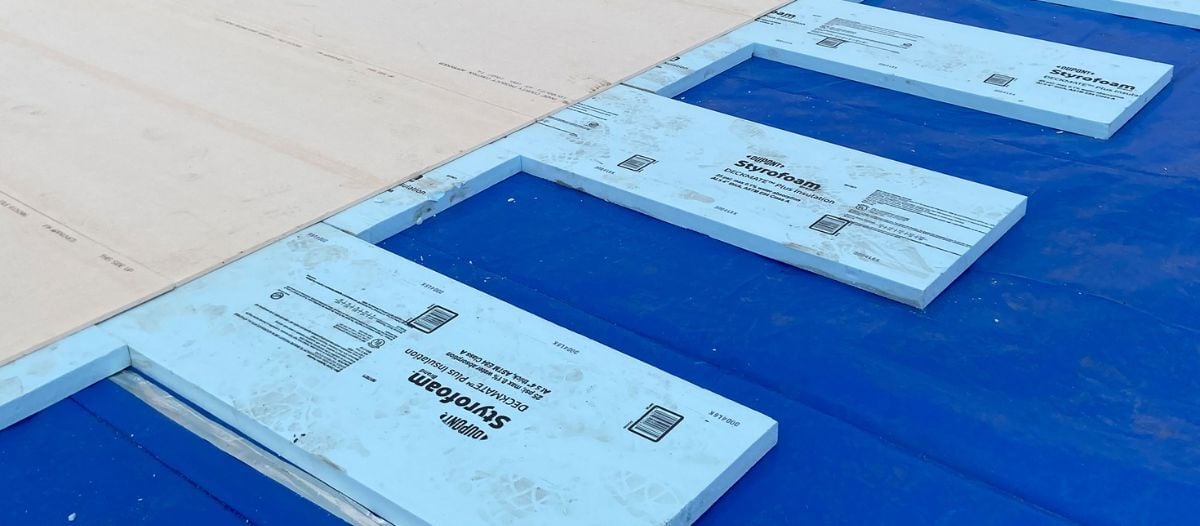The Power of Thickness
Understanding R-values

Facility managers and engineers are facing increasing pressure to ensure energy efficiency and sustainability in their buildings. One key aspect of achieving these goals is optimizing the insulation thickness and the corresponding R-values in commercial roofing systems. While the residential market often takes the spotlight, the importance of R-values in commercial roofs cannot be overstated.
What are R-values?
Measuring the thermal resistance of insulation materials, R-value determines how well a material can resist heat flow, helping to maintain the desired indoor temperature and reduce energy costs. Higher R-values indicate better insulation performance, which translates to improved energy efficiency. Various regions have specific code requirements that dictate the minimum R-values for different types of insulation based on climate zone, building design and usage. For instance, the International Energy Conservation Code (IECC) outlines R-value requirements for walls, roofs and floors in commercial structures, encouraging the use of high-performance insulation to optimize energy efficiency. FMs and engineers should familiarize themselves with the local building codes to select appropriate insulation materials that meet or exceed these R-value standards.
Shifting focus to air & vapor barriers
Traditionally, the focus has been on increasing insulation thickness to achieve higher R-values, which measure thermal resistance and are crucial for energy efficiency. However, modern advancements in building science have shifted this perspective, emphasizing the importance of integrating air and vapor barriers alongside insulation to create a more effective building envelope. These barriers play a crucial role in preventing air leakage and moisture infiltration, both of which can significantly impact the overall performance and longevity of the roofing system.
Air barriers
Air barriers are specifically designed to control the movement of air into and out of the building envelope. By effectively mitigating air leakage, they contribute to maintaining consistent indoor temperatures, reducing drafts and improving overall energy efficiency. In commercial roofing, air barriers are often meticulously integrated with the insulation system to enhance its effectiveness. This combination not only helps conserve energy but also minimizes the workload on heating and cooling systems, leading to reduced energy bills and a smaller carbon footprint over time.
Vapor barriers
Vapor barriers, on the other hand, serve a different yet equally important purpose. They are intended to prevent moisture from penetrating the insulation and causing damage over time. Moisture infiltration can lead to a host of issues, which include mold growth, reduced insulation performance and potential structural damage that can compromise the integrity of the building. By incorporating vapor barriers into the roofing system, builders and architects ensure that the insulation remains dry and functions optimally. This proactive measure not only enhances the durability of the insulation but also contributes to a healthier indoor environment by mitigating the risk of mold and other moisture-related problems. Overall, the thoughtful integration of air and vapor barriers is essential for achieving a high-performing, energy-efficient roofing system that stands the test of time.
 Enhancing the R-value of commercial roofs involves a multifaceted approach that goes beyond simply adding more insulation. Here are several strategies to achieve higher R-values in commercial roofing:
Enhancing the R-value of commercial roofs involves a multifaceted approach that goes beyond simply adding more insulation. Here are several strategies to achieve higher R-values in commercial roofing:
Select high-performance insulation materials
Choosing the right insulation material is paramount. Options such as polyisocyanurate (polyiso), and extruded polystyrene (XPS) offer high R-values per inch of thickness, typically ranging from 1 to 4 inches. These materials provide excellent thermal resistance while minimizing the overall thickness of the roofing system.
Layering insulation
Layering insulation materials can effectively increase the overall R-value of the roofing system. By combining different types of insulation with complementary properties, it is possible to achieve superior thermal performance. For instance, using rigid foam boards in conjunction with spray foam insulation can enhance both R-value and air sealing.
Why is layering so important? When underlying insulation joints are "buried" by subsequent layers, thermal loss is reduced at these critical junctions between adjacent boards. Furthermore, suppose moisture enters the roof assembly from the interior space via vapor drive. In this instance, the migration of that moisture upward to the underside of the roofing membrane is significantly reduced with multiple layers of insulation, curtailing the likelihood of condensation occurring. Layering of insulation can also reduce field membrane deficiencies like splitting and ridging.
Reduce thermal bridging
Insulation fasteners create a pathway for thermal transfer to and from the interior space, through the roof assembly, to the building exterior (and vice versa), which reduces the overall R-value of the roof assembly. When at least the top layer of insulation (or cover board) is adhered to instead of being mechanically attached, the pathway for thermal transfer is stopped short of the top of the roofing system, eliminating the thermal bridge.
Incorporate air & vapor barriers
Integrating air and vapor barriers with the insulation system is crucial for maximizing R-value in commercial and industrial facilities like warehouses, manufacturing plants and food processing plants. By preventing air leakage and moisture infiltration, these barriers help maintain the integrity of the insulation and enhance its performance. Proper installation and sealing of these barriers are essential for achieving the desired results.
Optimize insulation thickness
While increasing insulation thickness can improve R-values, there are practical limits to consider. Excessive thickness can lead to structural challenges and increased costs. Striking the right balance between insulation thickness and other factors, such as weight and space constraints, is key to optimizing the roofing system.
Is more better? Not necessarily. There is a threshold where adding additional layers of insulation is no longer effective in significantly increasing the overall R-value of the assembly. Adding more insulation at this point will only drive up the overall cost of the roof system, while not offering an impactful return on the investment in added insulation.
Conduct energy modeling
Energy modeling involves the use of specialized software to create detailed simulations of a building’s energy performance under different insulation configurations. FMs and engineers begin by inputting data related to the building's design, location and usage patterns, including materials, dimensions and occupancy rates.
Once the baseline model is established, they can manipulate various parameters, such as the type and thickness of insulation materials, window placements and HVAC systems, to assess how these changes impact energy consumption and comfort levels. The software runs simulations that model energy flows throughout the building, calculating heating and cooling loads, and identifying how much energy is saved with each configuration.
By analyzing the results, professionals can pinpoint areas where insulation can be improved, revealing cost-effective solutions that enhance energy efficiency. This iterative process allows for the testing of multiple scenarios, enabling teams to compare outcomes and select the insulation strategies that best align with their energy efficiency goals. Ultimately, energy modeling not only supports informed decision-making but also fosters a proactive approach to enhancing building performance over time.
Engage professional consultants
Partnering with experienced roofing consultants can make a significant difference in achieving optimal R-values. Consultants have the expertise to assess existing roofing systems, recommend suitable insulation materials and design comprehensive solutions that address the unique needs of each commercial building. Consultants will also take a deep dive into assessing the impact of interior operations on the roof system, factoring in where an air or vapor barrier may be advantageous, and exploring the optimum amount of insulation needed for the long-term performance of the roof system.
Optimizing the R-values of commercial roofs is a critical step toward achieving energy efficiency and sustainability goals. By focusing on high-performance insulation materials, incorporating air and vapor barriers, and employing strategic insulation techniques, facility managers and engineers can enhance the thermal performance of their buildings.
For more tailored solutions and expert guidance on optimizing a commercial roofing system, consider consulting with professionals who specialize in roof asset management. These experts can provide valuable insights and help ensure that the roofing system meets both current and future energy efficiency standards.

Casey Curry, RRO, a staff consultant at Benchmark since 2021, has been active in the roofing industry for more than 20 years. As a Certified Level I Infrared Thermographer, Curry employs advanced technology to detect trapped moisture and thermal loss in facilities. He is also a Registered Roof Observer and troubleshoots roofing and building envelope issues and develops comprehensive roof asset management programs for large, national clients
Read more on Project Management and Real Estate or related topics Asset Management and Building Systems
Explore All FMJ Topics









